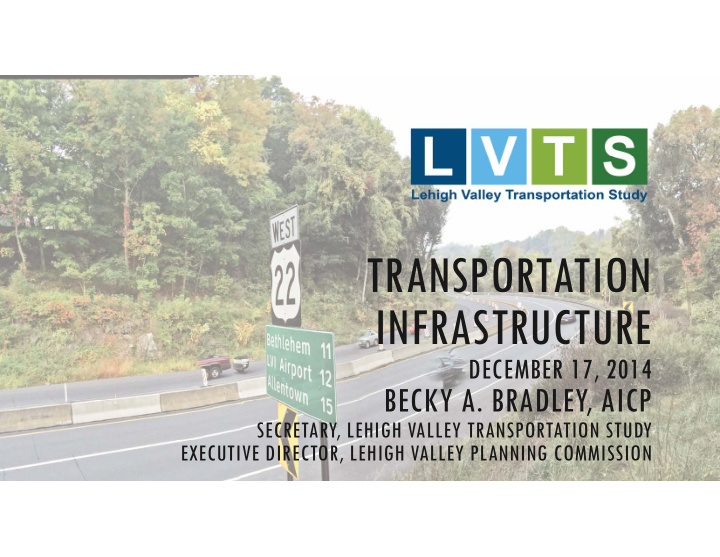



TRANSPORTATION INFRASTRUCTURE DECEMBER 17, 2014 BECKY A. BRADLEY, AICP SECRETARY, LEHIGH VALLEY TRANSPORTATION STUDY EXECUTIVE DIRECTOR, LEHIGH VALLEY PLANNING COMMISSION
• Metropolitan Planning Organization (MPO) • Federally-mandated and federally-funded transportation policy-making organization • Made up of representatives from local government and governmental transportation authorities • Established by the Federal-Aid Highway Act of 1962 Charged with developing strategies for operating, managing, maintaining, and financing the Lehigh Valley’s transportation system for the safety and security, growth and development, and quality of life of the region.
Coordinating Committee (Approval Body) Lehigh Valley Planning Commission Technical Committee (Advisory Body) PennDOT Central Office Lehigh Valley Planning Commission PennDOT District Office PennDOT Central Office Lehigh County PennDOT District Office Northampton County Allentown Allentown Bethlehem Bethlehem Easton Easton LANta LANta LNAA LNAA
WORK PRODUCTS Long Range Transportation Plan (LRTP) Comprehensive Freight Movement Plan (CFMP) Transportation Improvement Program (TIP) Safety Studies Congestion Management Process (CMP) Municipal Outreach, Education + Assistance Other: Transportation Alternatives Program (TAP) Multi-Modal Transportation Fund Program Green Light Go Program
Population Growth
Population Migration (2006 – 2010)
Population Density
Job Density
Employment Projections by Industry
Job Flows
Land Use
Distance to Fixed-Route Bus Stops
LONG RANGE TRANSPORTATION PLAN Purpose is to guide future transportation investment decisions Is a Federally-mandated program Plan must: Cover at least a 20 year period Be fiscally constrained Be intermodal in scope Include both short and long range elements
COMPREHENSIVE FREIGHT MOVEMENT PLAN First freight plan for the Lehigh Valley Piggybacks off the statewide freight plan currently under development Feeds the development of the LRTP Analyzes commodity flow data by: Value of goods Tonnage of goods Forecasts anticipated growth in goods movements Allows public dollars to be invested in freight including an inland port, future interchanges
TRANSPORTATION IMPROVEMENT PROGRAM List of high-priority highway, bridge, and transit projects to be implemented within the next 4 years utilizing Federal financial assistance Federally-mandated program Updated every 2 years Must be fiscally constrained 2015 – 2018 TIP: Highway Projects = $185,518,000 Bridge Projects = $140,721,000 Transit Projects = $56,066,000 Total Value = $382,305,000
PLACEHOLDER FOR HIGHWAY MAP
OTHER PROGRAMS Transportation Alternatives Program $1,326,191 awarded locally $964,939 awarded from the State (ex., Jordan Greenway Trail) Multi-modal Transportation Fund Program $5,476,621 awarded from the State (ex., LNAA Intermodal Center) Green Light Go Program New program resulting from Act 89 that funds traffic signal improvements. First round of funding to be awarded early 2015.
Process for Getting Projects onto the LRTP Proposed projects must be brought before LVTS for consideration and should include: project scope limits improvements – resurfacing, reconstruction, widening, mill & overlay, bridge replacement, sidewalk repairs, trail construction, etc. justification – Why is it needed? cost estimated by phase of work match handouts for committee members – 15 copies
Process for Getting Projects onto the LRTP (cont.) Proposed projects will be evaluated by LVTS for inclusion into the LRTP based upon compliance with: LRTP Goals and Policies Project need Project selection process Cost reasonableness Readiness for implementation Funding availability
Process for Getting Projects onto the LRTP (cont.) Project selection process for these project types: Congestion mitigation Safety Air quality Bridge Maintenance Other project types
CONGESTION MANAGEMENT PROCESS (CMP) Identifies corridors projected to be congested in 2030 & 2040 based upon: Traffic Volumes Accident Rates Corridor Length Level of Service Also used as a programming and project screening tool Feeds the Long Range Transportation Plan
Process for Getting Projects onto the LRTP (cont.) Congestion Mitigation Projects: Must be contained within the LVTS Congestion Management Program to be considered Proposed projects must fall within a CMP identified corridor Congestion problems outside the urban development boundary will not be addressed using federal or state money available to the MPO
SAFETY PLANNING Traffic Safety Plan for the Lehigh Valley 2008 – 2012 Identifies high crash corridors and intersections by crash type Is a project programming and screening tool Many improvements can be accomplished with low cost, quick delivery solutions
Process for Getting Projects onto the LRTP (cont.) Safety Projects: Proposed projects evaluated using PennDOT safety data comparing crash rates against statewide crash rates for highways with similar characteristics Proposed projects must have a crash rate greater than the statewide average for that type facility. Project is also measured against a PennDOT District 5 list of safety concerns.
Process for Getting Projects onto the LRTP (cont.) Air Quality Projects: Proposed projects that want to use congestion mitigation/air quality funds must go through an air quality test documenting reductions in VOCs and Nox. This is done using either the LVPCs regional travel demand forecasting model or the statewide model to determine air quality impacts. Projects are also measured against a PennDOT District 5 list of safety concerns.
Process for Getting Projects onto the LRTP (cont.) Bridge Projects: Proposed projects must have a sufficiency rating below 80 in order to be eligible for rehabilitation. Proposed projects must have a sufficiency rating below 50 in order to be eligible for replacement. If these criteria are not met, the project is not eligible for state or federal critical bridge funds. Highest priority for funding is given to closed, posted, and structurally deficient bridges.
Process for Getting Projects onto the LRTP (cont.) Maintenance Projects: Projects are generally proposed and prioritized by PennDOT and this typically deals with large maintenance projects only. Smaller maintenance projects are handled “off program” using PennDOT maintenance funds.
Process for Getting Projects onto the LRTP (cont.) Other Projects (direct application through respective program) Transportation Alternatives Program Multi-modal Transportation Program Green Light Go Program
Project Pitch Schedule before LVTS Technical Committee LVTS Technical Committee meeting – Tentative January 26, 2015 9:00 AM LVPC Conference Room 5 minute limit per project presentation PowerPoints welcome – provide to staff before meeting Handouts for LVTS members required All projects will be considered for inclusion
INVESTING IN THE LEHIGH VALLEY’S INFRASTRUCTURE
Recommend
More recommend